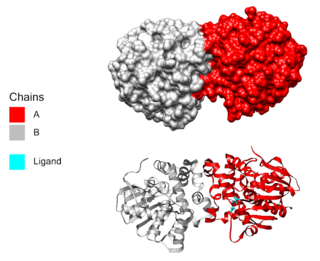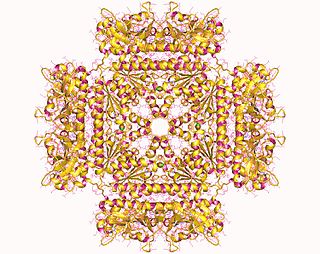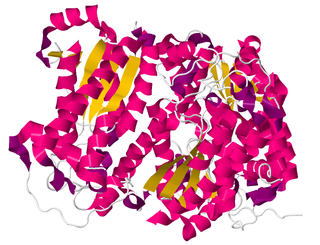
Oxaloacetic acid (also known as oxalacetic acid or OAA) is a crystalline organic compound with the chemical formula HO2CC(O)CH2CO2H. Oxaloacetic acid, in the form of its conjugate base oxaloacetate, is a metabolic intermediate in many processes that occur in animals. It takes part in gluconeogenesis, the urea cycle, the glyoxylate cycle, amino acid synthesis, fatty acid synthesis and the citric acid cycle.

Leukotriene A4 hydrolase, also known as LTA4H is a human gene. The protein encoded by this gene is a bifunctional enzyme which converts leukotriene A4 to leukotriene B4 and acts as an aminopeptidase.

In enzymology, a haloacetate dehalogenase (EC 3.8.1.3) is an enzyme that catalyzes the chemical reaction
In enzymology, a (S)-2-haloacid dehalogenase (EC 3.8.1.2) is an enzyme that catalyzes the chemical reaction

In molecular biology, the protein domain SAICAR synthase is an enzyme which catalyses a reaction to create SAICAR. In enzymology, this enzyme is also known as phosphoribosylaminoimidazolesuccinocarboxamide synthase. It is an enzyme that catalyzes the chemical reaction
In enzymology, a urea carboxylase (EC 6.3.4.6) is an enzyme that catalyzes the chemical reaction
The enzyme ADP-dependent short-chain-acyl-CoA hydrolase (EC 3.1.2.18) catalyzes the reaction
The enzyme lysophospholipase (EC 3.1.1.5) catalyzes the reaction
In enzymology, a 1-aminocyclopropane-1-carboxylate deaminase (EC 3.5.99.7) is an enzyme that catalyzes the chemical reaction
In enzymology, a 2-(acetamidomethylene)succinate hydrolase (EC 3.5.1.29) is an enzyme that catalyzes the chemical reaction
In enzymology, an acetylornithine deacetylase (EC 3.5.1.16) is an enzyme that catalyzes the chemical reaction
In enzymology, an agmatine deiminase (EC 3.5.3.12) is an enzyme that catalyzes the chemical reaction
In enzymology, an aminoacylase (EC 3.5.1.14) is an enzyme that catalyzes the chemical reaction

In enzymology, a creatininase (EC 3.5.2.10) is an enzyme that catalyses the hydrolysis of creatinine to creatine, which can then be metabolised to urea and sarcosine by creatinase.
In enzymology, a gamma-glutamyl-gamma-aminobutyrate hydrolase (EC 3.5.1.94) is an enzyme that catalyzes the chemical reaction
In enzymology, a guanidinoacetase (EC 3.5.3.2) is an enzyme that catalyzes the chemical reaction
In enzymology, a guanidinobutyrase (EC 3.5.3.7) is an enzyme that catalyzes the chemical reaction
In enzymology, a N-malonylurea hydrolase (EC 3.5.1.95) is an enzyme that catalyzes the chemical reaction
In enzymology, a proclavaminate amidinohydrolase (EC 3.5.3.22) is an enzyme that catalyzes the chemical reaction
A ureohydrolase is a type of hydrolase enzyme. The ureohydrolase superfamily includes arginase, agmatinase, formiminoglutamase and proclavaminate amidinohydrolase. These enzymes share a 3-layer alpha-beta-alpha structure, and play important roles in arginine/agmatine metabolism, the urea cycle, histidine degradation, and other pathways.





